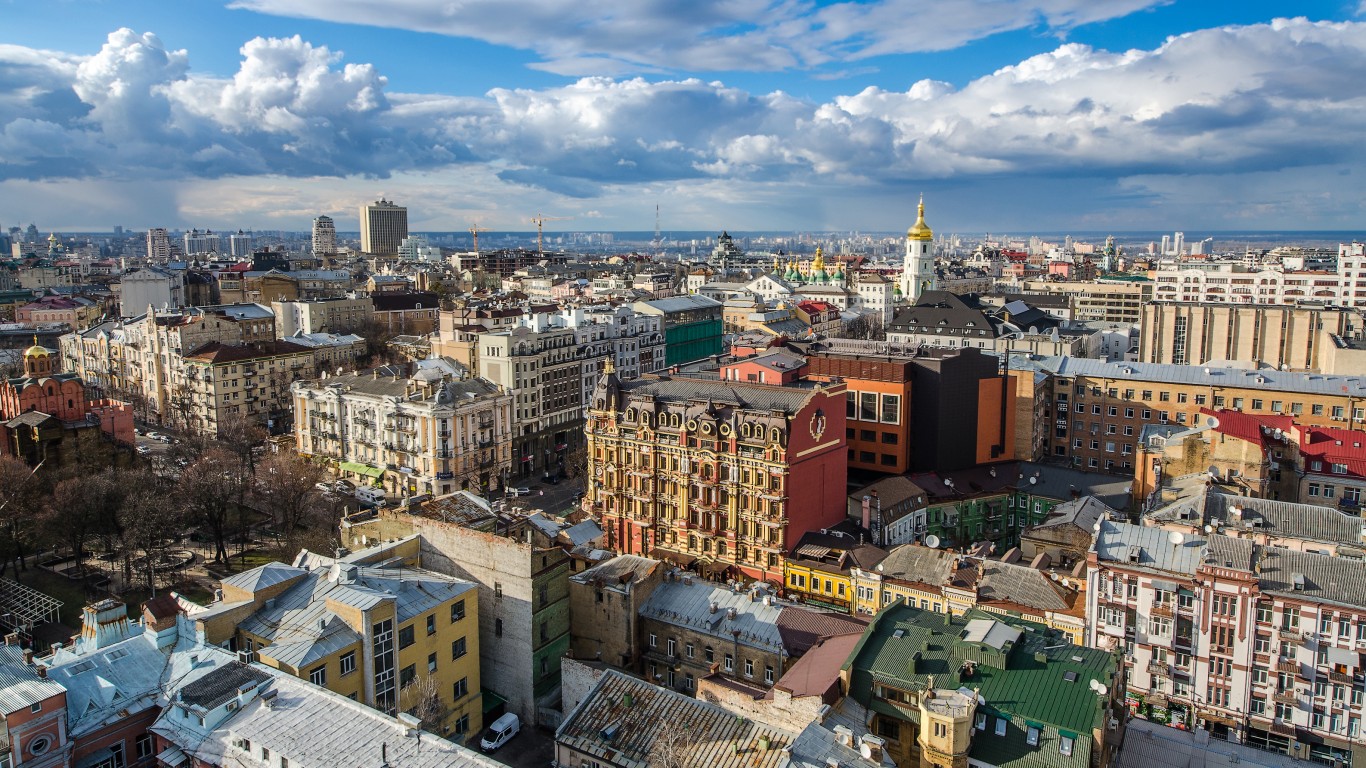
The world is in the throes of the latest COVID-19 variant, the fast-moving and highly transmissible omicron version of the coronavirus. The variant was first detected in South Africa in late November and quickly spread around the world. The Centers for Disease Control and Prevention said Tuesday that the variant accounted for 98% of COVID-19 cases in the U.S. last week. U.S. hospitals are once again stretched to their limits.
The pandemic wreaked havoc on the global economy, hitting certain industries particularly hard — including the tourism industry. Countries where tourism is an essential part of the economy have struggled in 2020 as tourism nearly ground to a halt. Tourism has since resumed, albeit not at levels prior to the pandemic, but it is again being hit, and there are fears this will continue. (The pandemic has devastated other sectors as well and is the reason some brands are failing. Here are famous brands that will disappear in 2022.)
To determine the 25 countries with the biggest tourism industries most likely to be hit hardest by COVID-19, 24/7 Wall St. identified the countries with the highest COVID-19 warning level from the CDC — Level 4: COVID-19 Very High — and ranked them by annual international tourism visits prior to the pandemic. Tourism and population data is from the World Bank.
The overwhelming majority of countries on this list are European, many of which are among the most fully vaccinated nations in the world.
The omicron variant arrived in Europe and the United States at the end of last year and ruined holiday travel plans. It forced some nations, such as the Netherlands, to impose lockdown measures and close nonessential businesses.
Similarly, Germany demanded a 14-day quarantine requirement on travelers arriving from the United Kingdom in late December, and France banned nonessential travelers from the U.K. that same month. Greece and Italy required proof of negative testing from all travelers, including those from the European Union.
However, there is reason for optimism. Preliminary studies have shown that omicron is less deadly than previous variants. And scientists believe the United States and other nations are nearing the peak of the omicron wave. The simple reason for that is the variant is so infectious it is running out of people to infect, experts explained.
Those in the hospitality industry in the U.S. and elsewhere have their fingers crossed that the worst is nearly over. (While some may shy away from traveling during the omicron wave, a road trip can be a safer option. Here are America’s most beautiful seaside road trips.)
Click here to see the most popular countries on CDC’s do not travel list
Click here to read our detailed methodology

25. Latvia
> Region: Northern Europe
> Annual pre-pandemic international tourists: 8.3 million
> Annual pre-pandemic visitor expenditure: N/A
> Population: 1.9 million
[in-text-ad]

24. Belgium
> Region: Western Europe
> Annual pre-pandemic international tourists: 9.3 million
> Annual pre-pandemic visitor expenditure: $10.6 billion
> Population: 11.6 million

23. Ireland
> Region: Northern Europe
> Annual pre-pandemic international tourists: 11.0 million
> Annual pre-pandemic visitor expenditure: $14.8 billion
> Population: 5.0 million

22. Switzerland
> Region: Western Europe
> Annual pre-pandemic international tourists: 11.8 million
> Annual pre-pandemic visitor expenditure: $21.3 billion
> Population: 8.6 million
[in-text-ad-2]

21. Bulgaria
> Region: Eastern Europe
> Annual pre-pandemic international tourists: 12.6 million
> Annual pre-pandemic visitor expenditure: $4.8 billion
> Population: 6.9 million

20. Ukraine
> Region: Eastern Europe
> Annual pre-pandemic international tourists: 13.7 million
> Annual pre-pandemic visitor expenditure: $2.6 billion
> Population: 44.1 million
[in-text-ad]

19. South Africa
> Region: Southern Africa
> Annual pre-pandemic international tourists: 14.8 million
> Annual pre-pandemic visitor expenditure: $9.1 billion
> Population: 59.3 million

18. Portugal
> Region: Southern Europe
> Annual pre-pandemic international tourists: 17.2 million
> Annual pre-pandemic visitor expenditure: $24.7 billion
> Population: 10.3 million

17. Netherlands
> Region: Western Europe
> Annual pre-pandemic international tourists: 20.1 million
> Annual pre-pandemic visitor expenditure: $25.9 billion
> Population: 17.4 million
[in-text-ad-2]

16. Saudi Arabia
> Region: Western Asia
> Annual pre-pandemic international tourists: 20.3 million
> Annual pre-pandemic visitor expenditure: $19.8 billion
> Population: 34.8 million

15. Russian Federation
> Region: Eastern Europe
> Annual pre-pandemic international tourists: 24.4 million
> Annual pre-pandemic visitor expenditure: $17.7 billion
> Population: 144.1 million
[in-text-ad]

14. Austria
> Region: Western Europe
> Annual pre-pandemic international tourists: 31.9 million
> Annual pre-pandemic visitor expenditure: $25.3 billion
> Population: 8.9 million

13. Canada
> Region: Northern America
> Annual pre-pandemic international tourists: 32.4 million
> Annual pre-pandemic visitor expenditure: N/A
> Population: 38.0 million

12. Denmark
> Region: Northern Europe
> Annual pre-pandemic international tourists: 32.9 million
> Annual pre-pandemic visitor expenditure: $9.1 billion
> Population: 5.8 million
[in-text-ad-2]

11. Greece
> Region: Southern Europe
> Annual pre-pandemic international tourists: 34.0 million
> Annual pre-pandemic visitor expenditure: $23.0 billion
> Population: 10.7 million

10. Czech Republic
> Region: Eastern Europe
> Annual pre-pandemic international tourists: 36.3 million
> Annual pre-pandemic visitor expenditure: $8.0 billion
> Population: 10.7 million
[in-text-ad]

9. Germany
> Region: Western Europe
> Annual pre-pandemic international tourists: 39.6 million
> Annual pre-pandemic visitor expenditure: $58.2 billion
> Population: 83.2 million

8. United Kingdom
> Region: Northern Europe
> Annual pre-pandemic international tourists: 40.9 million
> Annual pre-pandemic visitor expenditure: N/A
> Population: 67.2 million

7. Turkey
> Region: Western Asia
> Annual pre-pandemic international tourists: 51.7 million
> Annual pre-pandemic visitor expenditure: $42.4 billion
> Population: 84.3 million
[in-text-ad-2]

6. Croatia
> Region: Southern Europe
> Annual pre-pandemic international tourists: 60.0 million
> Annual pre-pandemic visitor expenditure: $12.0 billion
> Population: 4.0 million

5. Hungary
> Region: Eastern Europe
> Annual pre-pandemic international tourists: 61.4 million
> Annual pre-pandemic visitor expenditure: $10.2 billion
> Population: 9.7 million
[in-text-ad]

4. Poland
> Region: Eastern Europe
> Annual pre-pandemic international tourists: 88.5 million
> Annual pre-pandemic visitor expenditure: $15.7 billion
> Population: 38.0 million

3. Italy
> Region: Southern Europe
> Annual pre-pandemic international tourists: 95.4 million
> Annual pre-pandemic visitor expenditure: $51.9 billion
> Population: 59.6 million

2. Spain
> Region: Southern Europe
> Annual pre-pandemic international tourists: 126.2 million
> Annual pre-pandemic visitor expenditure: N/A
> Population: 47.4 million
[in-text-ad-2]

1. France
> Region: Western Europe
> Annual pre-pandemic international tourists: 212.0 million
> Annual pre-pandemic visitor expenditure: $71.0 billion
> Population: 67.4 million
Methodology
To determine the countries with the biggest tourism industries most likely to be hit hardest by COVID-19, 24/7 Wall St. identified the countries and territories with the highest COVID-19 warning level from the Centers for Disease Control and Prevention, and ranked them by annual international tourism visits. Our list reflects the 25 countries with the highest CDC warning and the most pre-pandemic yearly international visitors.
All countries on our list have a standing Level 4 warning from the CDC as of Jan. 11, 2022 — meaning the COVID-19 poses a very high risk and travelers are advised to avoid them.
All tourism data is from the World Bank and is for 2019, the most recent pre-pandemic year. Data for 2018 was used in rare cases where 2019 data was unavailable. Population data is also from the World Bank.
It’s Your Money, Your Future—Own It (sponsor)
Retirement can be daunting, but it doesn’t need to be.
Imagine having an expert in your corner to help you with your financial goals. Someone to help you determine if you’re ahead, behind, or right on track. With SmartAsset, that’s not just a dream—it’s reality. This free tool connects you with pre-screened financial advisors who work in your best interests. It’s quick, it’s easy, so take the leap today and start planning smarter!
Don’t waste another minute; get started right here and help your retirement dreams become a retirement reality.
Thank you for reading! Have some feedback for us?
Contact the 24/7 Wall St. editorial team.
 24/7 Wall St.
24/7 Wall St. 24/7 Wall St.
24/7 Wall St. 24/7 Wall St.
24/7 Wall St.


